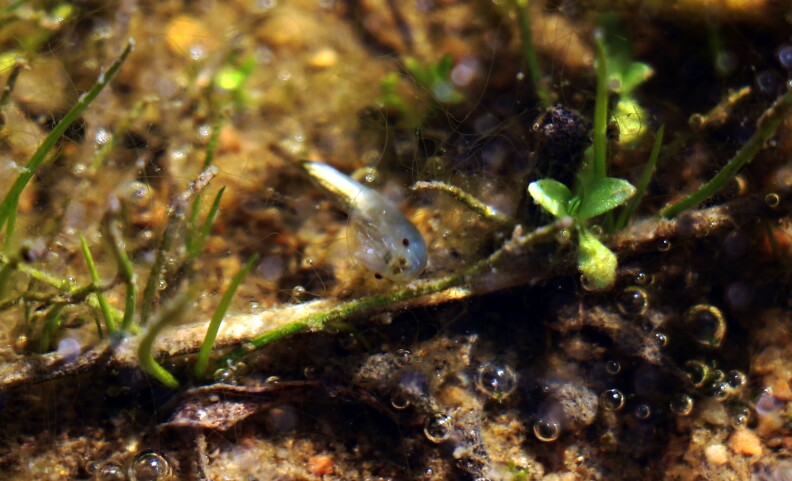Bodies of water across the United States are significantly more vulnerable to being destroyed following last week’s Supreme Court ruling that greatly narrowed the reach of the decades-old Clean Water Act.
One of the most impactful parts of the decision was to get rid of protections for wetlands that don’t have a “continuous surface connection” to larger bodies of water. These features are quite common across the West, which is covered in standalone wetlands, including what are known as ephemeral pools. They’re natural features that appear when it's wet and then disappear when it's dry.
Wetlands are kind of a big ecological deal, providing homes to all sorts of plants and animals, including those that are endangered, like the fairy shrimp here in Southern California. They also absorb vast amounts of water, help to sequester carbon dioxide, mitigate pollution and protect against flooding.

California’s long recognized their importance, pursuing a “no net loss” approach since the 1980s, but we’ve already destroyed an estimated 90% of our wetlands over time.
So, what does this change in laws mean for the few wetlands we have left?
California does have its own wetland protections
“Here in California we’re in pretty good shape thanks to a spread of state laws that will offer protections for wetlands,” said Noah Garrison, environmental science practicum director at UCLA’s Institute of the Environment and Sustainability.
While there are a large number of laws that influence the regulation of wetlands across California, the two primary ones are the Porter-Cologne Water Quality Control Act — after which the Clean Water Act was modeled — and the California Coastal Act, which affords comprehensive protection to wetlands along our coast for places like Bolsa Chica.
The overarching goal of the laws is to regulate how wetlands are both preserved and, in some cases, developed.
-
It's gonna be Yankees v the Boys in Blue
-
Nonprofit's launching fundraiser to keep it afloat
-
USC study documents what residents want from trees
Worries of waste in our water supply
Even though some states like California regulate disconnected wetlands, the loss of the federal regulation leaves questions about what’ll happen to wetlands elsewhere, including in the states that our water flows through, like Colorado and Arizona.
“Any of the waters, rivers or water bodies that we share with other states without those federal protections, that aren’t consistent across those other states, we’re just concerned about what will happen to the quality of those waters,” said Joaquin Esquivel, chair of the State Water Resources Control Board.
"Colorado River basin states — Arizona, Colorado, Nevada, New Mexico, Utah and Wyoming — do not have similar state laws protecting wetlands, and the Supreme Court’s decision on Sackett v. EPA could negatively affect water quality in the Colorado River watershed. But to what extent is unclear," wrote Metropolitan Water District spokesperson Rebecca Kimitch.
Before the decision, dredging, filling or dumping industrial and urban pollution in standalone wetlands was regulated by the federal government. The removal of those protections could potentially allow all sorts of discharge, which could eventually percolate its way into larger bodies of water like the Colorado River, and then downstream to us.
An increase in sediment from the dumping of dirt and sand, or pollution, into wetlands could add to our filtration costs, according to Escobel.
“Effectively you are now allowing pollution into source waters that feed into larger water bodies that we use for drinking water or water supply or agriculture,” said Garrison.

California has a lot to sort out on the development front
Previously, when a developer wanted to build on a potential wetland, they’d oftentimes have to get a permit from the Army Corp of Engineers, which would lead the process in determining if development could move forward. Bringing in other agencies to assess things like whether there are endangered species on the site, and if so, what can be done to mitigate the impact to them.
Oftentimes the permits were granted, but on occasion the wetlands either had to be preserved or sometimes the companies would be forced to pay into a wetlands bank.
Notably, the federal permitting process did a lot of the heavy lifting for the state, providing structure for landowners to follow, but now for many projects that process is gone. Leaving developers and the state in the lurch.
“It’s a big deal,” said Karrigan Börk, acting professor of law at the UC Davis School of Law. “This is going to put a lot of work back on the state.”
The Porter–Cologne Act should continue to protect all wetlands throughout the state, but both permitting and enforcement need to be sorted, with much of the work falling to individual agencies to pick up.
“California, like almost every other state, has not really effectively used statutory authority because it relied upon the federal government through the Army Corps of Engineers and to some extent the EPA to do that work. So now I think the state is gonna have to step up and do that work,” said Deborah Sivas, professor of environmental law at Stanford Law School.
There are questions around whether the infrastructure is there to consistently police violators — a problem that has arisen with regional water boards, like the one here in L.A., in the past.
The Clean Water Act allowed for watchdog groups to flag if someone was dumping without the proper permits, but there’s no citizens' suit in the Porter–Cologne Act, according to Sivas.
“That’s really for the state to step up and start enforcing the statute with respect to wetlands. Which they haven't really been doing,” she said.










